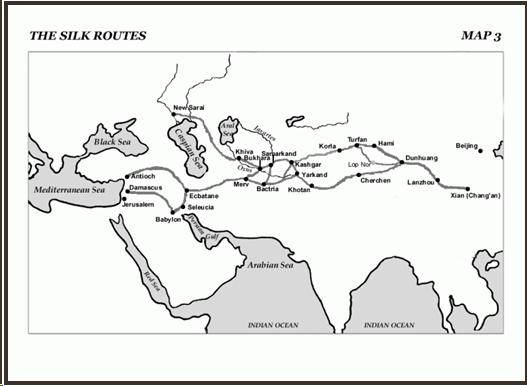

The Silk Road's many stages,
from Chang'an to Antioch
One of the two major "global" systems of commercial exchange in the pre-modern world was the Silk Road, a network of overland trading routes linking the Asian continent from China to the Levant, from which point both goods and people then reached Europe and the rest of the West. The Silk Road was the most significant commercial system of the ancient and medieval worlds, maintaining its supremacy until the European age of exploration and the subsequent shift of focus to the trading of goods to and from the "New World". It is not exactly clear when systematic, large scale trading began on the Silk Road. However, we do know that the western end of the trade route developed earlier than the eastern end, principally because of the development of the Persian and Roman empires in the west, and the easier terrain of the lands between them. By the second century B.C.E. trade had extended further east, thanks to the influence of China's Han Empire (which lasted from 206 B.C.E. to 220 C.E.). The earliest evidence of merchandise moving along the whole route from China to Rome, or vice versa, dates to about the middle of the second century C.E. The height of the Silk Road, however, is dated to the apex of the T'ang Dynasty from the seventh to the ninth centuries C.E. / In order truly to understand the history of the Silk Road, it is essential first to explain its name. Let me start by discussing the second part of the term, that is, the "Road" part of the network's name. It is crucial to know that the Silk Road was not one but multiple routes, traveled in stages, which I will explain in detail in a later slide. Now, what about the "Silk" part of the network's name? As many of you already know, the Silk Road was given its name because the major commodity traded along its routes was Chinese silk. Of course, this was but one of the commondities traded, which included also porcelain, jade, horses, metals, jewelry, and many other goods. / The nature of the Silk Road, as well as its organization and economics, was deeply influenced and ultimately determined by the geography of the lands along which it expanded. To begin, as I mentioned above, the Silk Road stretched from China to the Levant, that is, about 5000 to 6000 miles east to west as the crow flies (i.e. in a direct line, which is not actually possible). Even more influential to the nature of the network is the fact that the region separating China from Western Asia and Europe is one of the most inhospitable in the world. As Oliver Wild put it, much of this region "is taken up by the Taklimakan desert, one of the most hostile environments on our planet. There is very little vegetation, and almost no rainfall; sandstorms are very common, and have claimed the lives of countless people. The locals have a very great respect for this `Land of Death'… Temperatures soar in the sun, but drop very rapidly at dusk. Sand storms here are very common and particularly dangerous due to the strength of the winds and the nature of the surface. Unlike the Gobi desert, where there are a relatively large number of oases and water can be found not too far below the surface, the Taklimakan has much sparser resources." He continues, "The land surrounding the Taklimakan is equally hostile. To the northeast lies the Gobi desert, almost as harsh in climate as the Taklimakan itself; on the remaining three sides lie some of the highest mountains in the world. To the South are the Himalaya, Karakorum and Kunlun ranges… [while] to the north and west lie the Tianshan and Pamir ranges" respectively. In fact, the only way in coming from the west or south, is over the treacherous mountain passes which present serious difficulties to those traveling weighted down with goods to sell. As if this wasn't bad enough, transporting goods along these routes was made treacherous also by the fact that merchants are at risk of being robbed, at best, or killed at worst. All these realities meant that trade had to be conducted in specific ways, about which I will tell you in the next slide.